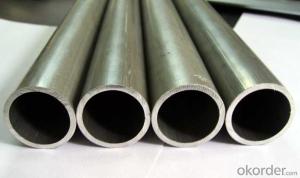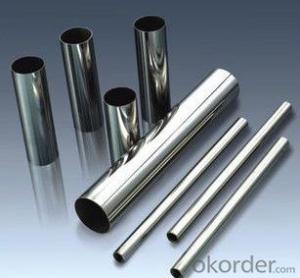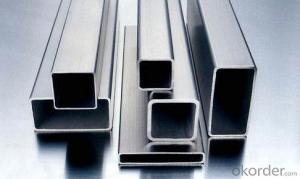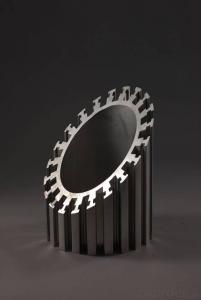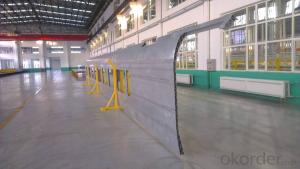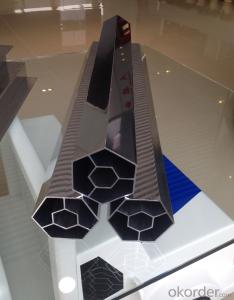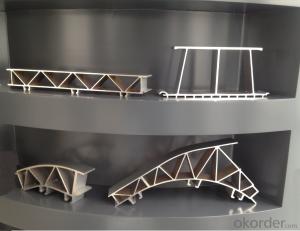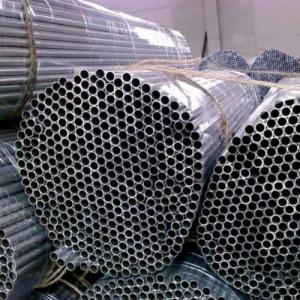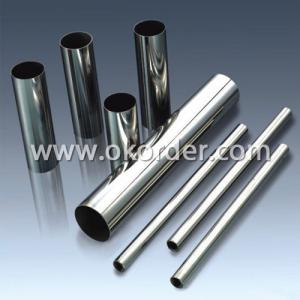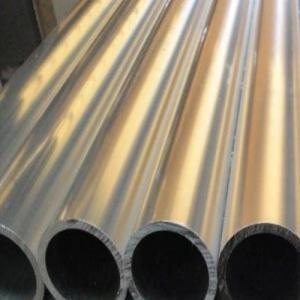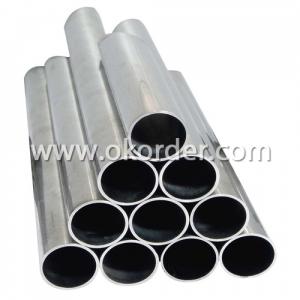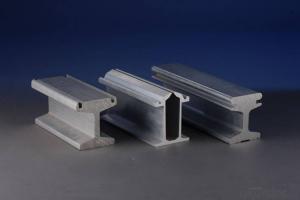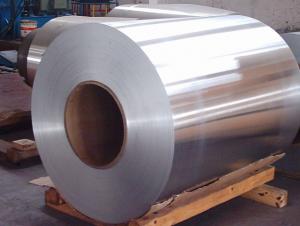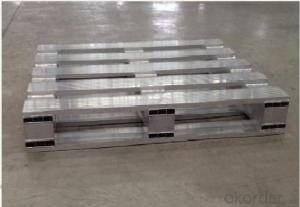Aluminum Seamless Tube Alloy 5000
- Loading Port:
- China Main Port
- Payment Terms:
- TT OR LC
- Min Order Qty:
- -
- Supply Capability:
- -
OKorder Service Pledge
Quality Product, Order Online Tracking, Timely Delivery
OKorder Financial Service
Credit Rating, Credit Services, Credit Purchasing
You Might Also Like
Specification of aluminum tube/pipe
Alloy: | 2A12, 2014, 2014A, 2017A, 2024, 3003, 5005, 5754, 5083, 7020, 7075 etc |
Temper: | O F T3-T6 |
Out diameter: | 15-220mm |
Wall thickness: | 1.0-60mm |
Length: | 6000mm or as need |
We can provide a full range services including: extrusion, anodizing, machining . we produce aluminium extrusions, aluminum tube, seamless aluminum tube, aluminum bar, aluminum angle, aluminum channels, and industry profiles, in a wide range of commercial alloys, including 1050, 1200, 2A12, 2014, 2014A, 2017A, 2024, 3003, 5083, 6005A, 6060, 6061, 6063, 6063A, 6082, 6463, 7020, 7075 subject to temper requirements and product specification.
Aluminium profiles(classifcation according to surface treatment requirements)
1,Anodizing profiles
2,Electrophresis profiles
3,Powder coating profiles
4,Wood finish profiles
5,Polished profiles
6,PVDF coating profiles
- Q:What are the different types of aluminum pipes available?
- Various applications have access to a range of aluminum pipes, each with distinct characteristics. 1. Seamless Aluminum Pipes: These pipes lack welds or seams, making them highly durable and capable of withstanding high pressure and temperature. Industries such as aerospace, automotive, and marine commonly employ seamless aluminum pipes. 2. Welded Aluminum Pipes: By welding together two or more aluminum pieces, these pipes provide a cost-effective solution suitable for applications that do not require the same strength as seamless pipes. Construction, irrigation, and HVAC systems often utilize welded aluminum pipes. 3. Extruded Aluminum Pipes: Shaping heated aluminum billets through a die results in continuous pipes with a constant cross-section. These pipes are lightweight, corrosion-resistant, and possess excellent thermal conductivity, making them prevalent in construction, automotive, and electrical industries. 4. Drawn Aluminum Pipes: Reducing the diameter and increasing the length of an extruded aluminum tube through a die produces drawn aluminum pipes with improved surface finish and tighter tolerances. Furniture, lighting fixtures, and heat exchangers frequently incorporate drawn aluminum pipes. 5. Aluminum Alloy Pipes: Aluminum alloys, consisting of aluminum mixed with elements like copper, magnesium, or zinc, form these pipes. Aluminum alloys enhance strength, corrosion resistance, and other pipe properties. Aerospace, automotive, and structural engineering industries utilize aluminum alloy pipes. When selecting an aluminum pipe, it is crucial to consider project or application-specific requirements, such as pressure rating, temperature resistance, corrosion resistance, and cost. Careful consideration of these factors ensures the most suitable option is chosen.
- Q:What's the difference between 3003 tubes and 6063?
- It is mainly used for high plasticity and good weldability, low load parts, working in a liquid or gaseous medium such as oil, gasoline or lubricating oil duct, various liquid containers and other small parts deep drawing load made of wire rod for rivet.6063 Aluminum Alloy is strengthened by heat treatment of alloy with moderate intensity in the system AL-Mg-Si, Mg and Si are the main alloy elements, widely used in frame construction aluminum doors and windows, curtain walls, doors and windows, in order to ensure the curtain has a high wind resistance performance, assembly performance, corrosion resistance and decorative properties, the comprehensive performance of the Aluminum Alloy profile demand is much higher than the standard industrial profiles.
- Q:Why is the copper tube of AUX air conditioning aluminum tube?
- The air conditioning aluminum tube is made of pure aluminium or aluminum alloy and is extruded into a hollow metal tube with longitudinal length. The air conditioning aluminum tube has "anneal"
- Q:How can the aluminum tube bending be processed and how to make manual bending equipment?
- How can aluminum tube bending be processed?Aluminum pipe to see what material, if 6063 or 6061, such as aluminum alloy, do not want to bend, and must be in the factory before the aging treatment bending, not without.
- Q:Can aluminum pipes be used for wastewater pipelines?
- Yes, aluminum pipes can be used for wastewater pipelines. Aluminum is corrosion-resistant and lightweight, making it a suitable material for wastewater transportation. However, the choice of pipe material depends on various factors such as the type of wastewater, its temperature, and the surrounding environment. It is recommended to consult with a professional engineer or plumbing expert to determine the most appropriate pipe material for a specific wastewater application.
- Q:Where do Beijing sell aluminium tubes, rectangular aluminum and aluminium?The best in Beijing area, the material should be quality assurance.You have to give me an address. Thanks
- There are cables for communication. Bar 5 and bar 7
- Q:Are aluminum pipes suitable for oil refineries?
- Yes, aluminum pipes can be suitable for oil refineries, depending on the specific requirements and conditions of the refinery. Aluminum pipes offer several advantages that make them a viable option for certain applications in oil refineries. Firstly, aluminum pipes are lightweight, which makes them easier to transport, install, and handle within a refinery facility. This characteristic can reduce the overall cost and time associated with the installation and maintenance of the piping system. Secondly, aluminum has a high corrosion resistance, especially when exposed to air. This quality is crucial in oil refineries where the pipes come into contact with various corrosive substances, such as crude oil, petroleum products, and chemicals. The resistance to corrosion helps prolong the lifespan of the pipes and reduces the need for frequent replacements or repairs. Additionally, aluminum pipes have excellent thermal conductivity. This property allows for efficient heat transfer within the refinery processes, which is essential for operations such as distillation, catalytic cracking, and oil separation. The high thermal conductivity of aluminum pipes can contribute to improved energy efficiency and cost savings. However, it is important to note that aluminum pipes may not be suitable for all applications in oil refineries. For instance, they may not be ideal for carrying highly pressurized fluids or in situations where high temperatures are involved, as aluminum has lower strength and melting point compared to other metals like steel. In such cases, steel or other alloys may be more appropriate. Overall, the suitability of aluminum pipes in oil refineries depends on the specific requirements, conditions, and limitations of the refinery processes. It is crucial to assess the compatibility of aluminum pipes with the operational needs of the refinery, taking into consideration factors such as pressure, temperature, and the nature of the fluids being transported.
- Q:Eddy current demonstrator's working principle: why does the magnet fall at different speeds in different aluminum tubes, while the aluminum tubes are the same?
- This is eddy current resistance. Used in a vibration system, that is, electromagnetic damping. The permanent magnet moves in the aluminum tube, and the magnetic field produced by the eddy current in the aluminum tube will resist the change of the magnetic field, that is to impede the movement of the magnet.
- Q:How do aluminum pipes perform in high-temperature environments?
- Aluminum pipes perform well in high-temperature environments due to their excellent thermal conductivity and resistance to corrosion at elevated temperatures. They can withstand sustained high temperatures without compromising their structural integrity, making them suitable for various applications in industries such as aerospace, automotive, and HVAC.
- Q:we have been cutting copper tube, now cutting aluminum tube, existing cutting machine cutting aluminum pipe burr is too big
- You cut the copper tube with plain saw blades, don't you? I don't know the thickness of the aluminum tube you cut If it is a thin wall tube, the blade will suggest making tooth tooth inclination increased, let teeth widened; if the wall thickness of pipes, apply with tungsten circular saw to cut.
1. Manufacturer Overview |
|
|---|---|
| Location | |
| Year Established | |
| Annual Output Value | |
| Main Markets | |
| Company Certifications | |
2. Manufacturer Certificates |
|
|---|---|
| a) Certification Name | |
| Range | |
| Reference | |
| Validity Period | |
3. Manufacturer Capability |
|
|---|---|
| a)Trade Capacity | |
| Nearest Port | |
| Export Percentage | |
| No.of Employees in Trade Department | |
| Language Spoken: | |
| b)Factory Information | |
| Factory Size: | |
| No. of Production Lines | |
| Contract Manufacturing | |
| Product Price Range | |
Send your message to us
Aluminum Seamless Tube Alloy 5000
- Loading Port:
- China Main Port
- Payment Terms:
- TT OR LC
- Min Order Qty:
- -
- Supply Capability:
- -
OKorder Service Pledge
Quality Product, Order Online Tracking, Timely Delivery
OKorder Financial Service
Credit Rating, Credit Services, Credit Purchasing
Similar products
New products
Hot products
Hot Searches
Related keywords
